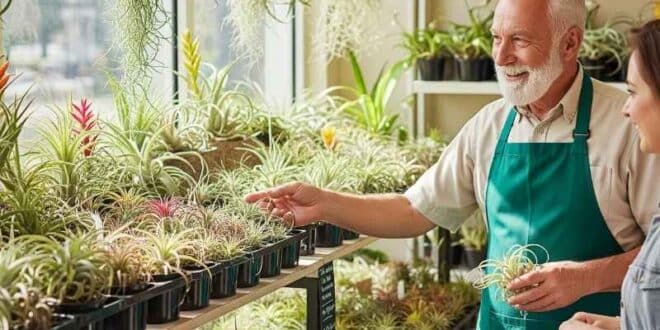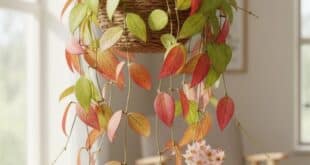Let’s Meet The Air Plants
Imagine a plant that doesn’t need soil, happily floats or clings to almost anything, and looks like it just drifted in from a fairy tale. That’s the enchanting world of Air Plants! These remarkable plants, scientifically known as Tillandsia, are truly extraordinary and unique members of the plant kingdom.

Hailing from diverse landscapes across the Americas, from steamy rainforests to dry deserts, Air Plants bring an instant touch of modern magic and natural art to any space. They’re perfect for anyone, from curious beginners to seasoned plant enthusiasts, especially if you love creative displays or have limited space. Excited to uncover the secrets of nurturing these captivating, soil-free wonders? Let’s dive into how these incredible plants thrive and flourish!
What Makes an Air Plant So Unique? No Soil Needed, Just Air and Water!
The most incredible thing about an Air Plant is right there in its name: it doesn’t need soil to grow! This is because they are epiphytes, which means they naturally grow by clinging to trees, rocks, or other plants in their native habitats, getting all their water and nutrients directly from the air, rain, and debris that collects around them.
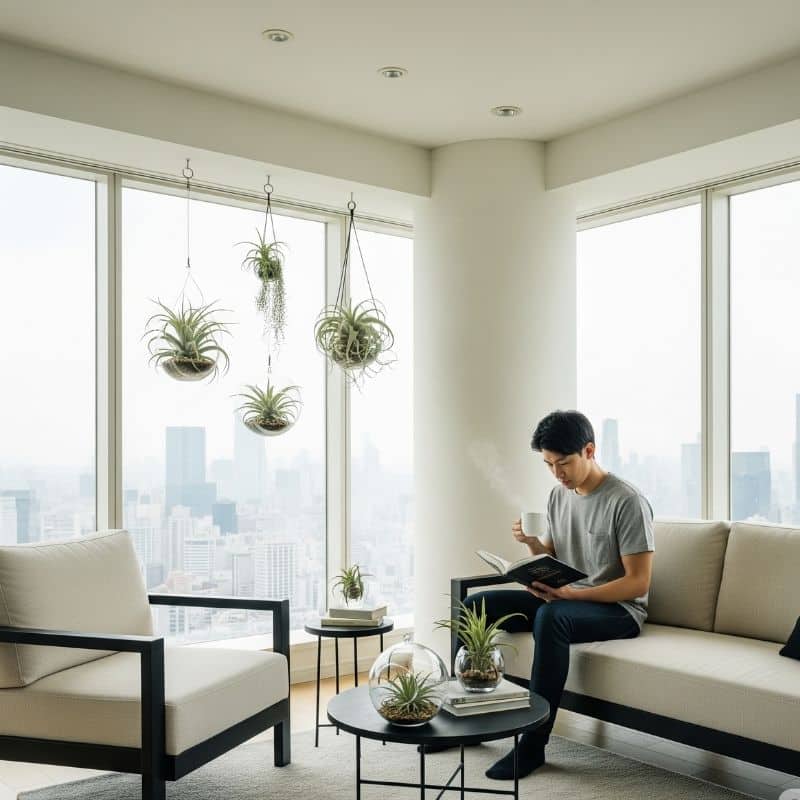
If you look closely at their leaves, you’ll see tiny, fuzzy, silvery scales called trichomes. These are special cells that act like little sponges, soaking up moisture and nutrients from the air around them. Each Air Plant has its own unique look – some are spiky, some are curly, some are fuzzy and silver, others are smooth and green. They truly are living sculptures!
💡 Great spot for an image! You could add a beautiful, close-up photo here showcasing an Air Plant’s unique shape and the fuzzy texture of its trichomes.
Where Do Air Plants Come From? Americas’ Rainforests and Deserts
Your Air Plant’s ancestors come from an incredibly wide range of habitats across North, Central, and South America. You’ll find them naturally living everywhere from the humid, misty rainforests of Ecuador to the dry, sunny deserts of Mexico! This amazing adaptability helps explain why there are so many different types, each a little bit special in how it looks and what it needs.
What Are Its Other Names? “Tillandsia” and Its Mystical Appeal
The most commonly used nickname for this plant is “Air Plant,” but its scientific name is Tillandsia. This name is used for the entire genus, which includes hundreds of different species! The enduring appeal of Air Plants comes from their almost mystical quality – they seem to float in the air, bringing a sense of wonder and effortless nature into our homes, making them perfect for minimalist or artistic displays.
What Kinds of Air Plants Are There?
The world of Air Plants is truly vast, with hundreds of species, each with its own charm. They can be broadly grouped by their water needs, which often relates to their looks!
Popular Air Plant Types: A World of Shapes and Textures
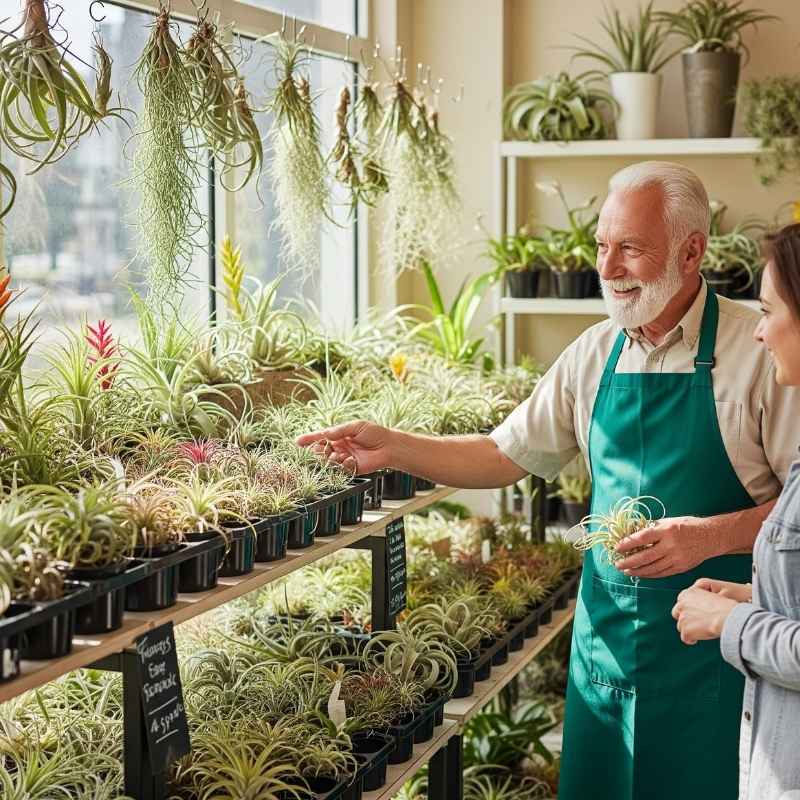
Air Plants showcase an incredible diversity of shapes, sizes, and textures. Here are some common and popular types you might come across:
| Type Category | Key Features & Examples | Looks Like… | Watering Hint |
| Xeric (Silvery/Fuzzy) | More fuzzy/silvery leaves, better adapted to dry air. Often larger. Ex: Tillandsia xerographica, T. ionantha, T. tectorum | A shaggy, silvery sculpture; T. ionantha blushes red when blooming. | Less frequent soaking. |
| Mesic (Green/Smooth) | Greener, smoother leaves, prefer more humidity. Often smaller. Ex: Tillandsia caput-medusae, T. brachycaulos, T. bulbosa | Smooth, green, often with curly or bulbous bases (like an octopus!). | More frequent soaking/misting. |
💡 Great spot for an image! You could add a collage here showing different Air Plant types like a fuzzy T. xerographica, a spiky T. ionantha (blushing red!), and a curly T. caput-medusae.
Looks and Textures: From Spiky to Fuzzy and Silver
The sheer variety of Air Plant forms is captivating. Some are small and spiky, like little green stars. Others are large, with dramatic, curly silvery leaves. Many have that unique fuzzy texture from their trichomes, which makes them feel soft and look almost frosted. Colors range from various shades of green to silvery-grey, and many will beautifully “blush” vibrant reds or pinks when they’re about to flower, making them even more stunning!
Growth Habit: Clinging and Clumping
Air Plants don’t have roots for absorbing nutrients from soil (since they don’t use soil!). Rather than absorbing nutrients, the roots of air plants primarily serve to anchor them securely to surfaces such as tree branches, rocks, or other structures. As they grow, they’ll produce little “pups” (baby plants) from their base. If you let these pups grow, your Air Plant can gradually form a beautiful, multi-plant clump!
How Do You Take Care of Your Air Plant?
Caring for Air Plants is quite different from traditional potted plants, but once you get the hang of it, it’s wonderfully easy and quite satisfying! The key is understanding their unique way of “drinking” and “eating.”
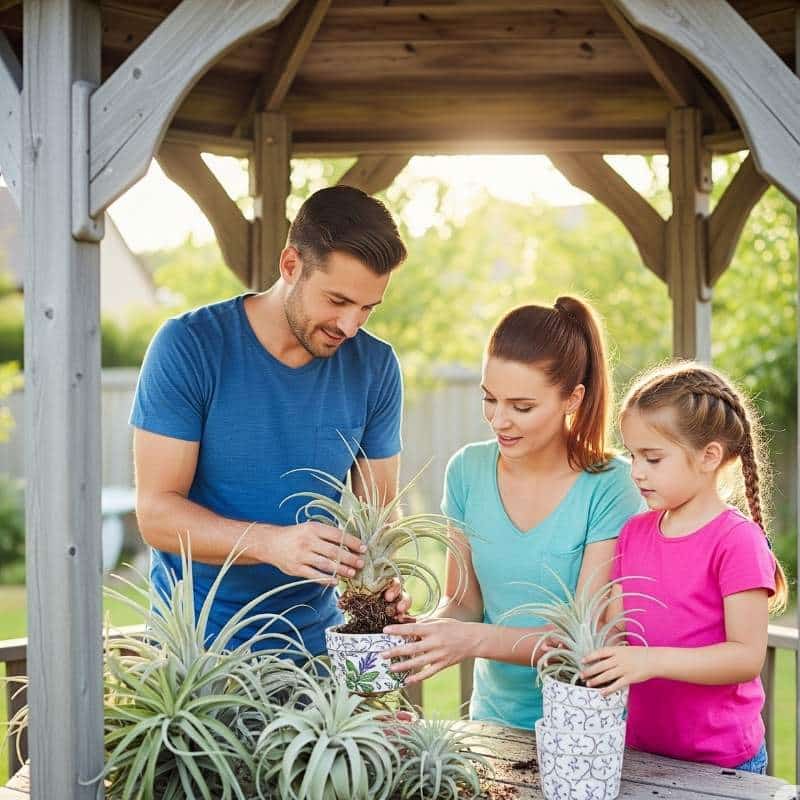
Air Plant Care Summary
Here’s a quick overview of what your magical Air Plant loves:
| Care Category | What Your Air Plant Needs |
| Light | Bright, indirect light (essential for health & blooms). Some direct morning sun is okay. |
| Watering | Soak (20-30 mins) once a week for most. Mist 2-3 times/week. Crucially: dry upside down completely! |
| Airflow | Good air circulation (prevents rot, helps dry after watering). |
| Temperature | Warm, 60-80°F (15-27°C); avoid cold drafts. |
| Fertilizing | Monthly to bi-monthly during spring/summer with diluted Tillandsia/orchid fertilizer. |
The Right Light: Bright, Indirect is Best!
Your Air Plant loves bright, indirect light. Think of a bright room that doesn’t get harsh, direct sun all day. A spot near an east or west-facing window is usually ideal. Some direct morning sun is generally fine, but intense afternoon sun can easily scorch their delicate leaves. If they don’t get enough light, they might look dull, not grow much, and won’t produce those beautiful blooms.
Watering Smart: Soaking and Misting Are Key!
This is the most unique part of Air Plant care! Since they don’t have soil, they get their water through their leaves:
- Soaking: The best way to water is to give your Air Plant a good bath! Submerge the air plant entirely in a bowl of room-temperature water for 20–30 minutes once a week to keep it hydrated. For fuzzier, silvery types (Xeric), you might only need to do this every two weeks.
- Misting: You can also mist your Air Plant 2-3 times a week, especially for greener, smoother types (Mesic) or if your home is very dry. Misting isn’t usually enough as a sole watering method, though.
- The Golden Rule: After any watering (soaking or heavy misting), it is crucial to shake off excess water and then place your Air Plant upside down (or on its side) on a towel in a well-ventilated spot to allow it to dry completely within 2-4 hours. This prevents water from sitting in the base, which leads to deadly rot!
Temperature and Airflow: Warmth and Good Air Circulation
Your Air Plant will be happiest in warm temperatures, ideally between 60-80°F (15-27°C). Keep it away from cold drafts from open windows or air conditioners. Also, good air circulation is incredibly important. It helps the plant dry quickly after watering, which is key to preventing rot. Don’t trap them in closed, unventilated spaces after a soak.
Feeding Your Air Plant: Special, Light Meals
Air Plants don’t need a lot of food, but a little bit can help them grow and bloom! During their active growing season (spring and summer), you can fertilize them once a month or every other month. For optimal growth, use a specialized Tillandsia fertilizer or an orchid fertilizer diluted to about 1/4 of its recommended strength. You can add this to their soaking water.
What Are Common Problems with Air Plants and How to Fix Them?
Air Plants are pretty tough, but they’ll definitely show you if something’s not quite right. Here’s what to look out for:
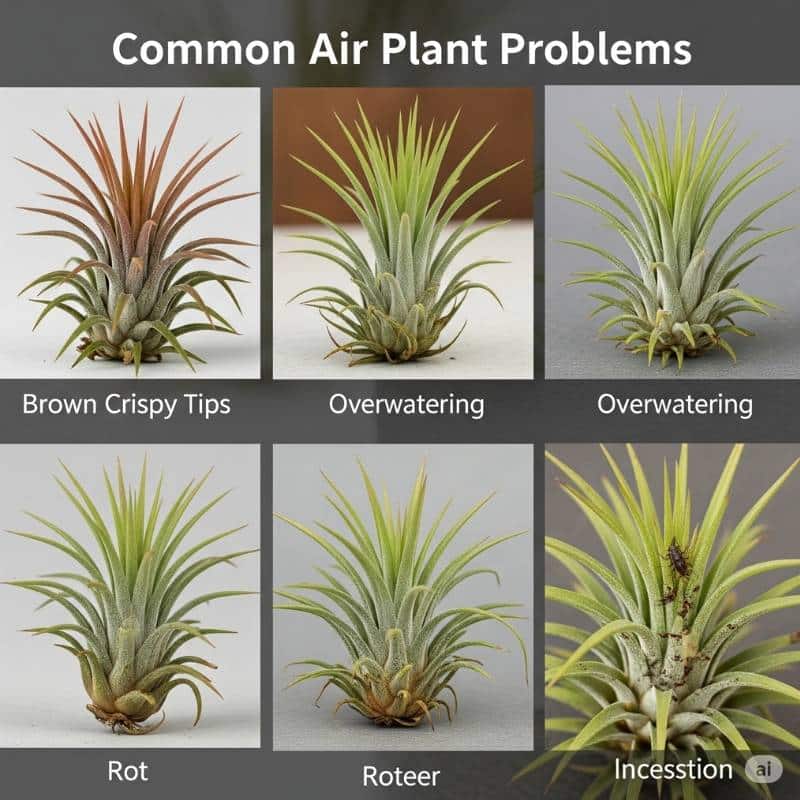
Common Air Plant Problems & Solutions
| Problem | What It Looks Like | Common Cause(s) | How to Fix |
| Browning/Crispy Tips | Leaf tips are dry, brown, or shriveled | Underwatering, low humidity, dehydration | Increase watering frequency (longer soaks), boost room humidity. |
| Mushy Base/Falling Apart | Base is soft, dark, or plant pieces separate | Overwatering, not drying completely after watering (leading to rot) | This is serious! Ensure plant dries completely upside down within hours after watering. Less frequent soaks. |
| No Blooms | Plant isn’t flowering | Not enough bright light, lack of fertilizer, immaturity, not proper species. | Move to brighter indirect light. Fertilize during growing season. Be patient, some types rarely bloom indoors. |
| Fading Colors/Dull Look | Leaves look less vibrant, losing luster | Not enough light | Move to a spot with more bright, indirect light. |
| Excessive Curling | Leaves are tightly curled inward | Very thirsty! Severe dehydration | Give a long soak (1-2 hours), then dry thoroughly. Increase soaking frequency. |
Is the Air Plant Toxic? Safety for Pets
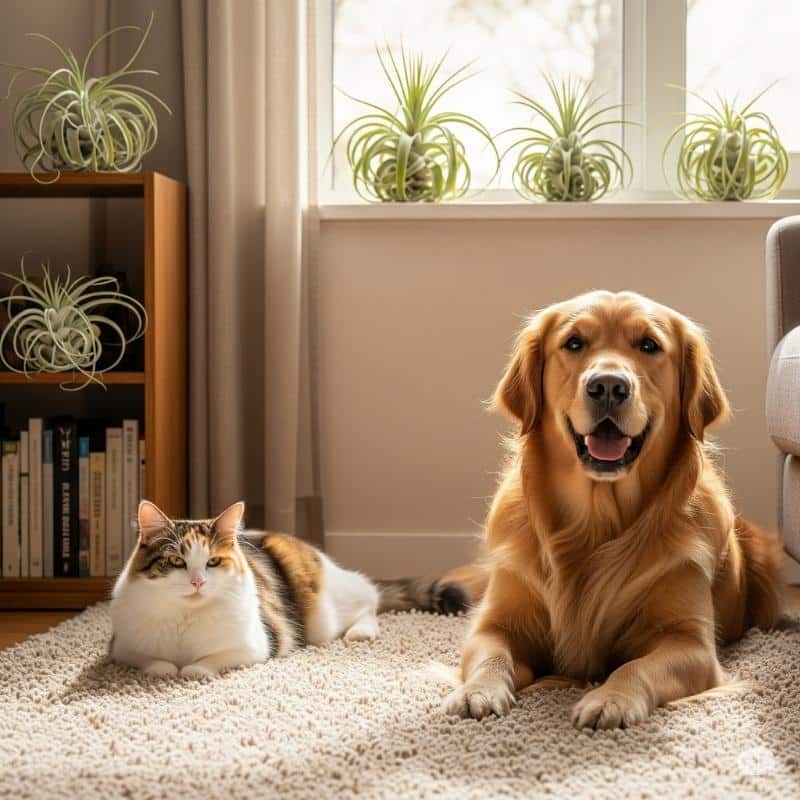
Good news for pet owners! According to the ASPCA (American Society for the Prevention of Cruelty to Animals), most Air Plant species (Tillandsia spp.) are generally considered non-toxic to cats, dogs, and horses. What a relief! This makes them a relatively safe choice for households with curious furry friends who might occasionally take a nibble.
While they’re considered non-toxic, it’s always smart to gently discourage your pets from eating large amounts of any plant material, just in case it causes a mild upset tummy. But you can generally feel at ease displaying these beauties in your home with pets around.
Air Plant for Home Decor: Modern Minimalism and Creative Displays
Air Plants are a designer’s dream since they don’t require pots! This unique feature unlocks endless creative possibilities for home décor, such as:
Creating Unique Displays: No Pots Needed!
Since Air Plants don’t require soil, they can literally cling to almost anything—rocks, wood, shells, or even unconventional items like magnets and jewelry! You can nestle them on pieces of driftwood, glue them to decorative rocks, arrange them in open terrariums (making sure they dry out fully!), or display them in cool geometric metal holders. The possibilities are endless for creating unique, living art.
💡 Great spot for an image! You could add a photo here of an Air Plant displayed creatively on driftwood or in a geometric holder.
Perfect for Small Spaces and Desks
Many Air Plant varieties are quite compact, making them absolutely perfect for small spaces, apartment living, or simply adding a touch of green to your desk, bookshelf, or bathroom counter. They take up minimal space but offer maximum charm.
Adding Natural Texture and Organic Feel
Each Air Plant is a unique little sculpture, with fascinating shapes and textures. They bring a wonderful natural, organic feel to any room, adding subtle visual interest even in the most minimalist settings.
💡 Great spot for an image! A photo here showing various Air Plant shapes and textures displayed together would be excellent!
The Allure of Air Plants: Magical, Minimalist, and Marvelous
The Air Plant truly is a magical addition to any plant collection. It offers a captivating blend of unique beauty, a wonderfully minimalist approach to care (no soil!), and incredible versatility in how you can display it. Whether you’re looking for a low-maintenance conversation starter, a creative decor element for a small space, or simply a fascinating living wonder, the Air Plant is a truly marvelous choice. It’s a reminder that nature always finds a way to surprise and delight us!
Frequently Asked Questions (FAQ) About Air Plants
Still have some questions about these amazing Air Plants? Here are some common ones that might help you out!
Q1: How do I water an air plant?
A1: The best way is to soak them! Submerge your Air Plant completely in a bowl of room-temperature water for 20-30 minutes once a week. After soaking, shake off excess water and place it upside down on a towel to dry completely within a few hours to prevent rot. You can also mist them 2-3 times a week as a supplement.
Q2: Do air plants need soil?
A2: No! This is what makes them unique. Air Plants are epiphytes, meaning they naturally grow on other surfaces (like trees or rocks) and absorb all their water and nutrients through their leaves from the air. Putting them in soil will actually cause them to rot.
Q3: How often do air plants bloom?
A3: Air Plants typically bloom once in their lifetime, usually when they are mature. The bloom spike (inflorescence) can last for weeks or even months! After blooming, the “mother” plant will usually start to produce “pups” (baby plants) from its base.
Q4: Why is my air plant turning brown or crispy?
A4: If your Air Plant is turning brown or crispy, especially at the tips, it’s almost always a sign of dehydration or underwatering.
- The Fix: Give it a longer, more frequent soak (try 1-2 hours) and ensure it’s drying completely afterward. Increase misting if your home is very dry.
Q5: How long do air plants live?
A5: The lifespan of an Air Plant varies by species and care, but generally, a single plant can live for several years. After it blooms, the mother plant will slowly decline, but it will produce several “pups” that you can separate and grow into new plants, continuing the cycle!
Q6: Can I put my air plant in a closed terrarium?
A6: Air Plants love humidity, but they need good air circulation to dry out after watering. A completely closed terrarium can trap too much moisture and lead to rot. If using a terrarium, ensure it has plenty of ventilation or is open-faced to allow for proper drying.
Q7: Do air plants need direct sunlight?
A7: Most Air Plants prefer bright, indirect light. Some fuzzier, silvery types (xeric) can tolerate a bit of direct morning sun, but intense, direct afternoon sun can easily scorch their leaves.
Q8: How do I know if my air plant is getting enough water?
A8: A well-hydrated Air Plant will have plump, firm leaves. If the leaves start to curl more excessively than normal, look shriveled, or feel soft and flimsy, it’s a clear sign of dehydration.
Q9: Is it normal for air plants to have roots?
A9: Yes! Air Plants do have roots, but their purpose is primarily for anchoring the plant to a surface (like a tree branch) in its natural habitat, not for absorbing water or nutrients. You can trim away dead or unruly roots without harming the plant.

